The Netherlands may be known as a country of cyclists, but the Dutch also have impressive road infrastructure and one of the densest motorway networks in the world. However, if you plan on driving in the country, you’ll need to become familiar with the various road rules and regulations.
So to help you get on the road, this article about driving in the Netherlands explains the following:
- Driving in the Netherlands
- Who can drive in the Netherlands?
- How to get your Dutch driving license
- Drivers with disabilities in the Netherlands
- Car registration and maintenance
- Driving costs in the Netherlands
- Driving rules and penalties
- Road signs in the Netherlands
- Traffic information in the Netherlands
- Parking in the Netherlands
- Road accidents and breakdowns
- Cars in the Netherlands
- Car repair in the Netherlands
- Tips for driving in the Netherlands
- Useful resources
FBTO
Driving in the Netherlands? You'll need a car insurance premium that suits your lifestyle. With FBTO, you can supplement your basic cover with add-ons that meet your driving needs, including roadside assistance and occupants insurance. Enjoy 24/7 emergency support and peace of mind by taking out a policy with FBTO.
Driving in the Netherlands
The Netherlands is a small country with an extensive and well-maintained road network. Highways connect all major towns, making it convenient to drive to and from different cities, regions, and even neighboring countries. In many ways, driving in the Netherlands is similar to driving in other European countries and motorists drive on the right-hand side of the road.
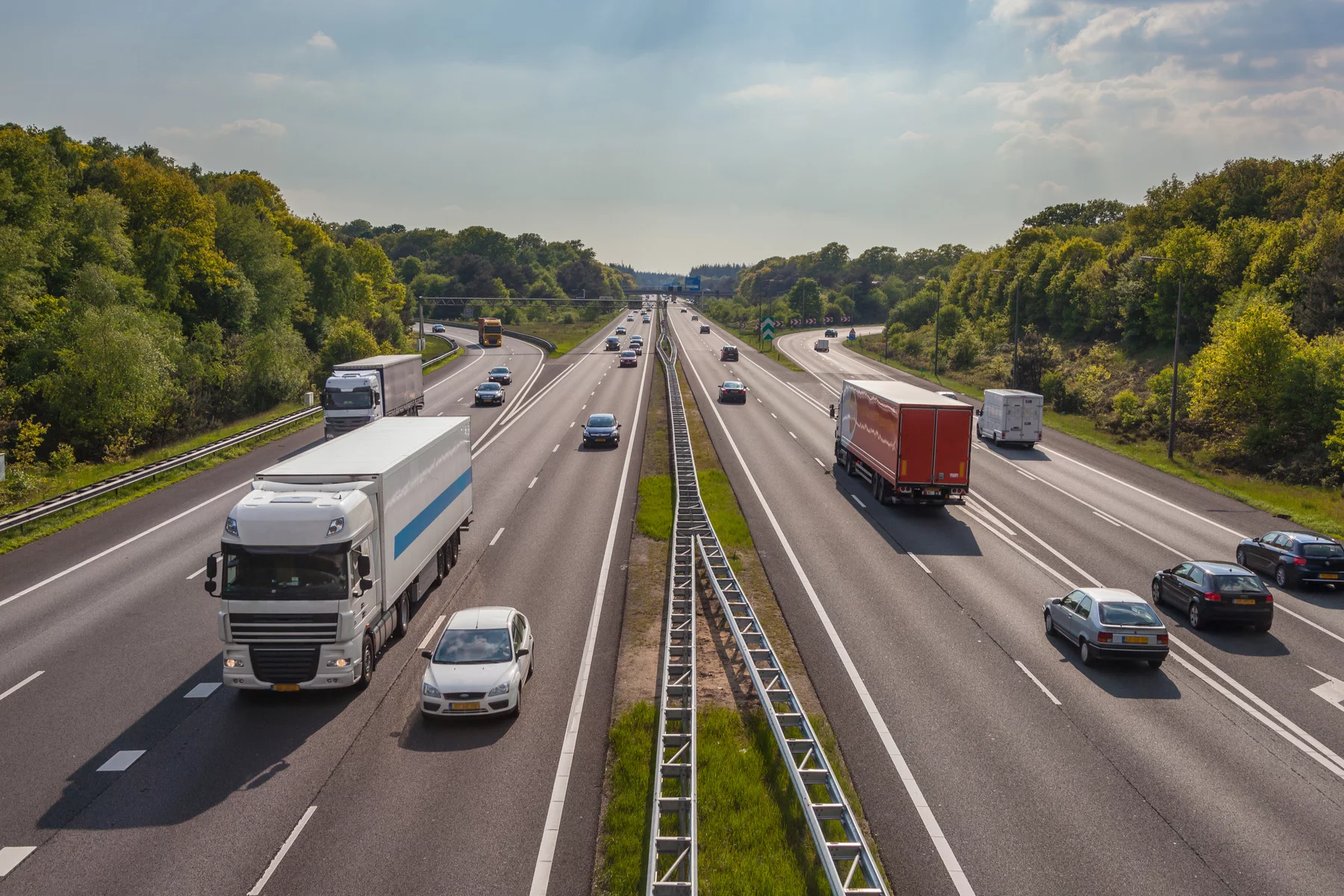
Car ownership in the Netherlands is very high, and in 2020, there were 8.7 million passenger cars in the country, with almost 50% of the population owning one.
The main regulatory body for road transport in the Netherlands is the Rijksdienst voor het Wegverkeer (RDW). They are responsible for tasks involving the licensing of vehicles, monitoring the condition of vehicles, and issuing vehicle documentation.
The Netherlands is home to one of the world’s largest electric charging infrastructure networks. The Netherlands Enterprise Agency, known as Rijksdienst voor Ondernemend Nederland (RVO), has set a zero-emission target for all new passenger vehicles by 2030.
Who can drive in the Netherlands?
To legally drive in the Netherlands, you must be at least 18 years old and have a full valid driving license, which is known as rijbewijs. You should also have third-party liability car insurance (WA-verzekering), a certificate of car ownership (tenaamstellingsbewijs or tenaamstellingscode), and a vehicle registration card (kentekencard or kentekenbewijs).
Expats are allowed to drive with a foreign driving license in the Netherlands up until a certain time period. If your driving license was issued in an EU/EFT country, you can continue using your foreign license for 15 years. However, if your license was issued in a country outside an EU/EFTA country, you can only use your license for 185 days after you first register at your local municipality in the Netherlands.
How to get your Dutch driving license
All drivers in the Netherlands must possess a valid driving license issued by the RDW. There are several types of Dutch driving licenses that authorize the use of a different category of vehicle. These include categories:
- A – motorcycles
- B – cars and other automobiles
- C – trucks
- D – buses
- T – agricultural and forestry tractors
You can find out more information about these categories on the RDW website.
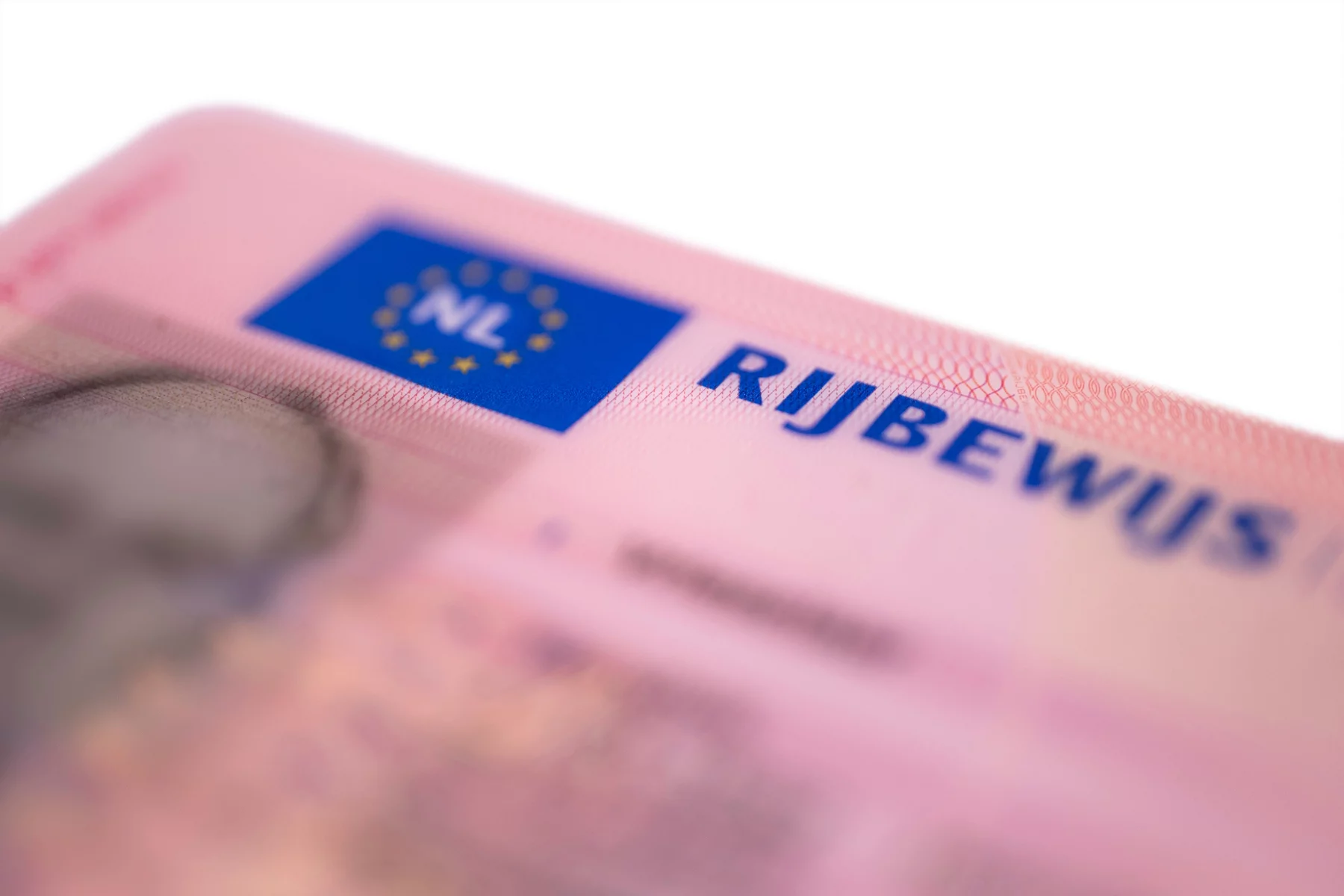
The standard driving license includes:
- License holder name
- Place and date of birth of license holder
- Issue date and expiry date of license
- Citizenship of license holder
- Local municipality (gemeente)
- Citizen service number (burgerservicenummer – BSN)
- Driving license number
- Photo of license holder
- Signature of license holder
- Vehicle categories the license holder is permitted to drive
Getting a driving license
The minimum age to get a full driving license in the Netherlands is 18. However, a national scheme enables you to start taking driving lessons when you are 16 and a half. From the age of 17, you can drive accompanied by an RDW-registered guardian, known as begeleider, until you turn 18.
After passing your driving test for the first time, the RDW will issue you with a beginner’s license. This license is valid for five to seven years, depending on your age. A new driving license costs a maximum of €38.83.
In order to get your driving license, you must do the following:
- Select a driving school to take driving lessons
- Pass your theory and practical driving test with the Centraal Bureau Rijvaardigheidsbewijzen (CBR)
- You must also take a health assessment to confirm that you are physically and mentally fit to drive
- Apply for a driving license at your local gemeente
Exchanging a foreign driving license
If you have a valid driving license that was issued from abroad before you moved to the Netherlands, you can continue using this license for a certain period of time. However, the length of this transition period depends on the country where you originally obtained your license.
You can exchange your foreign license at your local municipality (gemeente) which will forward your application to the RDW. Alternatively, you can arrange to take a Dutch driving test at the CBR.
Drivers with disabilities in the Netherlands
If you live with a disability that leads to reduced mobility, you can apply for an EU disability parking card (Europese gehandicapteparkeerkaart – GPK). You can use this card in all EU countries to gain access to parking spaces designated for cardholders. When using your EU disability parking card, you should display it at the front of the vehicle so it is clearly visible.
You can apply for an EU disability parking card at your local gemeente. You can learn more about applying for this card here.
If you require access to a wheelchair or need to have accessibility modifications made to your car, you can apply for support from the Social Support Act, which is known as Wet Maatschappelijke Ondersteuning (WMO), from your local gemeente.
Car registration and maintenance
Car registration
All cars in the Netherlands must be registered with the RDW. If you have a Dutch ID, you can register ownership of your car at any PostNL registration desk, a Kentekenloket BV registration desk, or an RDW counter in your area.
You will need to provide the following:
- identification documents
- a certificate of ownership
- vehicle registration documents
- proof of statutory liability insurance
- a safety certificate known as Algemene Periodieke Keuring (APK)

If you are importing a vehicle from abroad, you must take your car to an RDW inspection station to ensure that it complies with Dutch safety and emissions standards. Once your car has been registered, you will receive a vehicle registration certificate (kentekenbewijs) in credit card form along with a certificate of car ownership (tenaamstellingsbewijs).
Car maintenance
All vehicles registered in the Netherlands must have a periodic technical inspection (PTI) which is called an APK. After your car passes its inspection, you will receive an inspection report (keuringsrapport). You can have your vehicle tested at any RDW-approved garage or test center of your choice in the Netherlands.
The RDW website provides a PTI inspection schedule that lets you know how often your car needs to be inspected. You can also check the expiry date of your PTI inspection using the RDW registration certificate check. In most cases, your car’s first inspection should take place four years after its registration. After this, it needs to be tested every two years, then annually.
If your car fails the PTI, you must carry out the necessary repairs and take it back to a test center for re-inspection. Notably, driving on public roads in the Netherlands without a valid inspection report can result in a fine from the police or the RDW.
Driving costs in the Netherlands
Excluding the cost of driving lessons, tests, and your license, you can expect to pay the following expenses when driving in the Netherlands:
- Car maintenance – An APK inspection can cost between €20 and €75 depending on which garage or test center you visit
- Fuel costs – Gasoline in the Netherlands currently costs around €2.01 per liter
- Electric car charging – The price per kWh in the Netherlands is around €0.20 to €0.30 on average
Road tolls
All roads and motorways in the Netherlands are free of toll charges. Only heavy goods vehicles weighing over 12 tonnes need to have a valid Eurovignette electronic tag to drive on motorways.
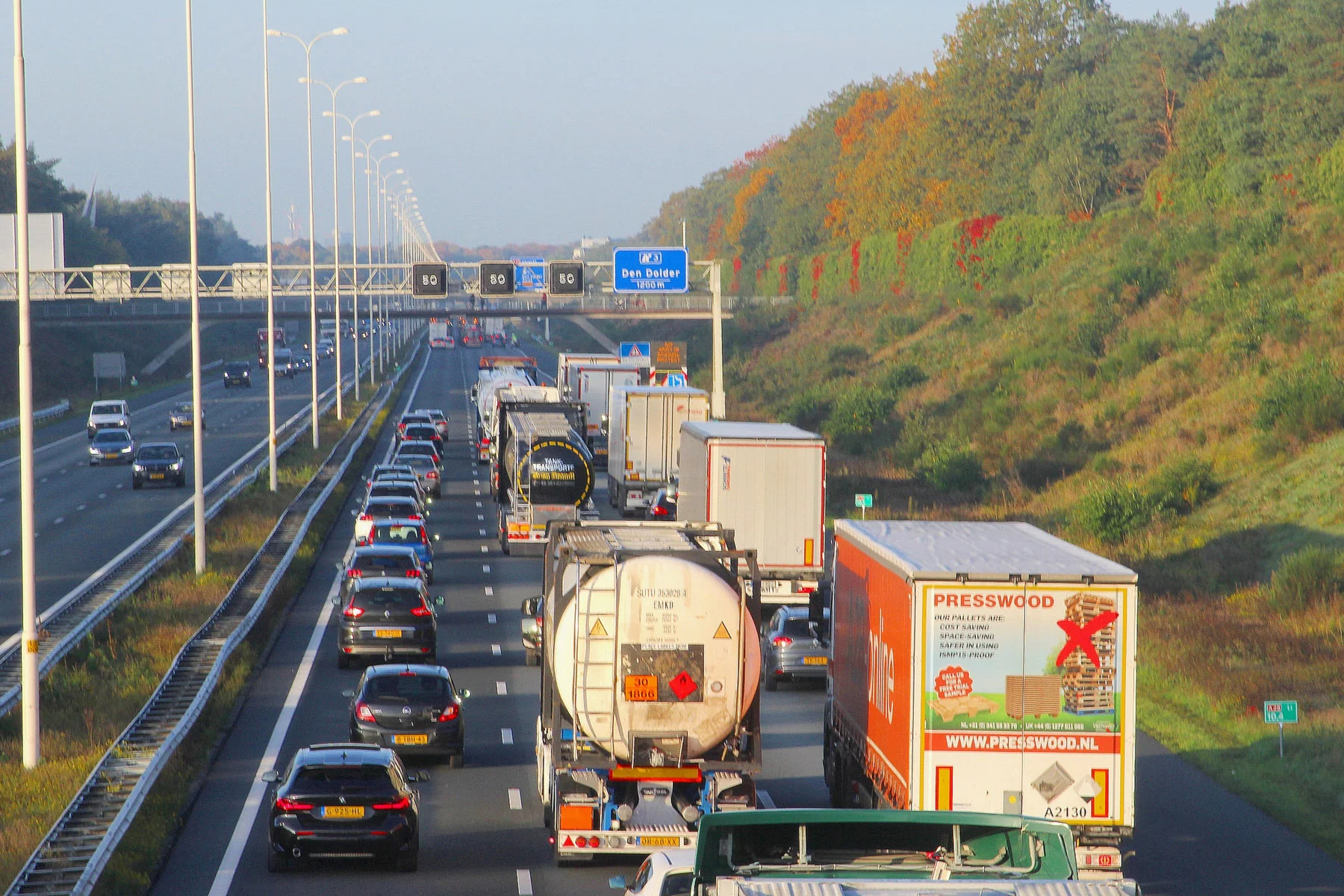
The Netherlands has just two toll tunnels: the Westerscheldetunnel, which costs €5, and the Kiltunnel which costs €2.00 in cash or €1.45 by card.
Private motor vehicle tax
If you buy a vehicle in the Netherlands or import one from abroad, you must pay private motor vehicle and motorcycle tax, which is known as belastingen op personenauto’s en motorrijwielen (BPM).
How much you will need to pay depends on a variety of factors. The Belastingdienst (Dutch Tax and Customs Administration) website provides information about specific rates for your type of vehicle.
Once you have paid the BPM, the RDW will send you a vehicle registration card within five working days.
Road tax
After registering your car, you will automatically receive a bill for road tax (motorrijtuigenbelasting) once every quarter. The amount you owe depends on your type of car and where you live. You can pre-calculate the costs for road tax on the Belastingdienst website.
Car insurance
Car insurance is mandatory for all drivers in the Netherlands. According to Dutch law, you must have third-party liability car insurance (WA-verzekering), which covers you against any damage or injury caused to others by your vehicle. Other types of optional car insurance include extended liability (WA-beperkt casco) and all-risk (allriskverzekering).
Some of the largest car insurance providers in the Netherlands include:
Car insurance rates vary depending on a number of factors, including your driving history, experience, and the value of your vehicle. The average car insurance costs around €75 per month. You can compare car insurance quotes using online comparison tools from platforms like Independer, Overstappen.nl, and United Consumers.
You can find out more about auto coverage, including the requirements for taking out a policy, in our article on car insurance in the Netherlands.
Driving rules and penalties
Dutch driving rules conform to most European regulations. Even so, it’s advisable to read up on Dutch traffic rules to avoid on-the-spot fines for traffic violations.
General road rules
- Drive on the right-hand side of the road and overtake on the left side
- Give way to vehicles coming from the right, unless otherwise stated
- Priority roads are indicated with yellow diamond-signed roads
- Drivers on a roundabout have the right of way
- All vehicle occupants must wear a seatbelt; children under 1.35 meters must sit in a child seat in the rear of the car
- Mobile phones may only be used with a hands-free system while driving
- Motorcycle drivers and passengers must wear crash helmets
- Use dipped headlights after dark and in misty conditions
- Only use high-beam headlights at night
- In built-up areas you can only use your horn in dangerous situations; if necessary, flash your lights instead
The Ministry of Infrastructure and the Environment (Ministerie van Infrastructuur en Waterstaat) published a comprehensive guide (in English) on Road Traffic Signs and Regulations in the Netherlands which is available online.
It is also mandatory to keep the following items in your car while on the road:
- A valid driving license (rijbewijs)
- Vehicle registration card or certificate (kentekenbewijs)
- Registration certificate or code (tenaamstellingsbewijs)
- Proof of car insurance
- Red warning triangle (in the event of a breakdown, this must be placed 30 meters behind your car)
- Car accident report form
Minor traffic offenses are dealt with by the Centraal Justitieel Incasso Bureau (CJIB) from the Ministerie van Justitie en Veiligheid (Ministry of Justice and Security). Unlike other countries that calculate fines using a table, the Netherlands calculates fines based on the gravity of the offense in particular contexts. The Openbaar Ministerie (Public Prosecution Service) also uses fixed fine rates for many violations. For instance, using a mobile phone while driving and driving through a red light will incur a €250 fine.
Speed limits in the Netherlands
Speed limits in the Netherlands are as follows unless otherwise marked by signs:
- Built-up areas: 50 km/h
- Outside a built-up area: 80 km/h
- Motorways: 100 km/h between 06:00 and 19:00, or 130 km/h between 19:00 and 06:00. When the rush-hour lane is open, an adjusted maximum speed of 80 or 100 km/h applies.
Speeding penalties increase according to how much the driver exceeded the speed limit and whether the offense took place in a residential area, in a 30 km/h zone, or on the highway. You can calculate speeding fines online on the Openbaar Ministerie website.
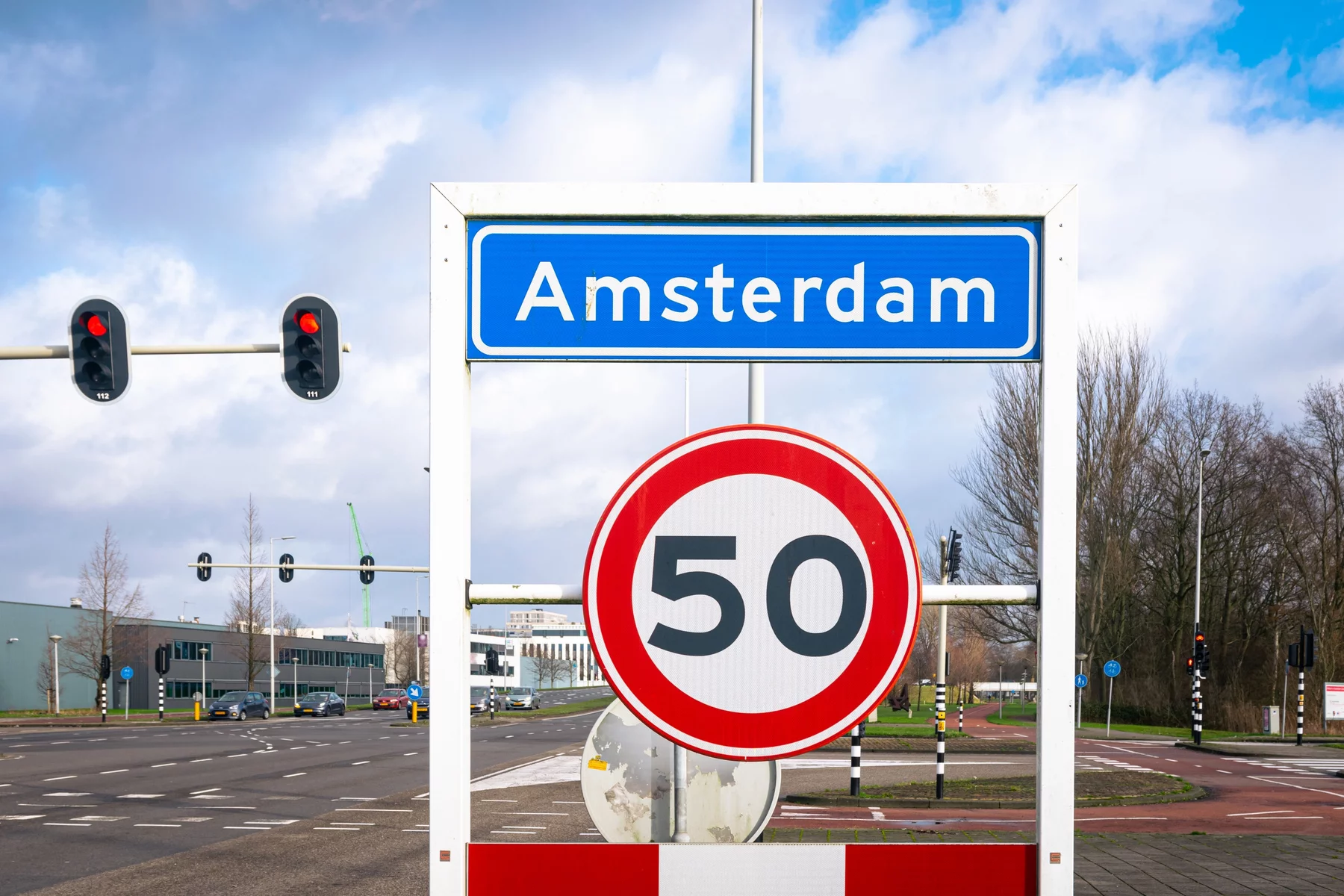
Speed limit enforcement is extensive on roads in the Netherlands. This includes speed bumps and signs on highways to help reduce vehicle speed. Fixed speed cameras are also in operation on many roads and motorways. The Centraal Justitieel Incasso Bureau (CJIB) will send you a fine by post if you are caught speeding.
Driving under the influence
It is illegal to drive with a blood-alcohol level of 0.05% or above. For drivers who have held their license for less than five years, the blood alcohol limit is 0.02%. This lower limit also applies to drivers under the age of 24, along with drivers of motorcycles and scooters.
Since 2017, the Netherlands has enforced statutory limits on the use of drugs while driving. You can find the limits for different substances on the Dutch government’s website.
If you are found guilty of driving under the influence of alcohol or drugs, you could be fined or face a prison sentence from the Openbaar Ministerie. A court may also suspend your driving license for up to five years.
Distracted driving laws
Drivers in the Netherlands are not allowed to hold a phone, navigation system, tablet, or music player while driving. You can only use these devices with a hands-free setup or if your vehicle is parked or stationary. You can be fined €250 if you are caught using one of these handheld devices while driving.
Driving without a license
If you are caught driving without a license, you can be fined between €100 and €370 depending on your particular circumstances. This includes driving with a license that has exceeded its expiration period by over a year, or driving with the wrong category license.
Road signs in the Netherlands
If you are familiar with road signs across western Europe, Dutch traffic signs should be easy to understand.
The main categories of Dutch road signs include:
- Diamond signs (usually yellow) – priority signs
- Red triangular signs – warning signs
- Red circular signs – prohibitive signs
- Blue circular signs – instructional signs
- Square and rectangular signs – informative signs
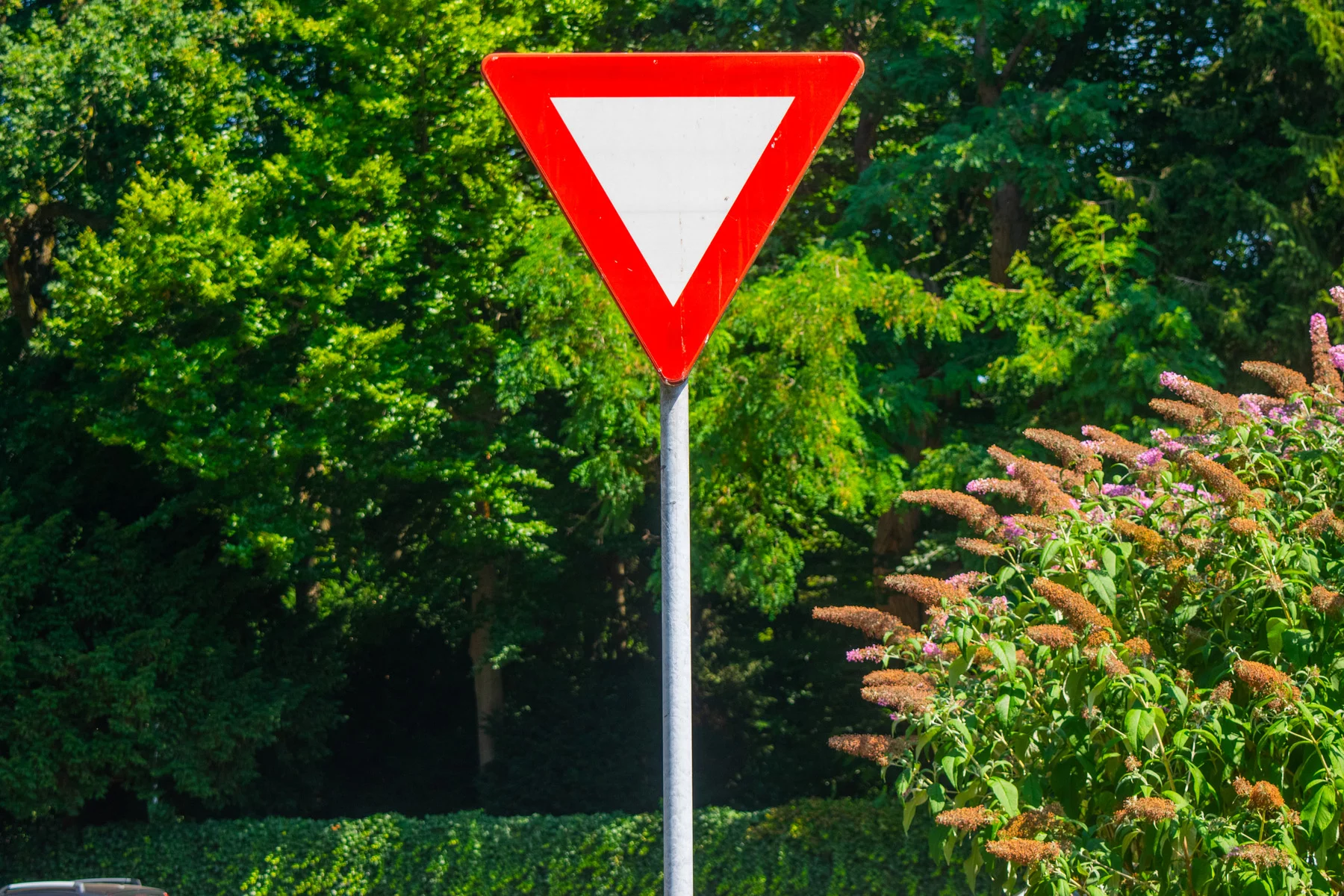
The Ministerie van Infrastructuur en Waterstaat offers a digital overview of all traffic signs in the Netherlands on its website.
Traffic information in the Netherlands
The Netherlands currently ranks 76th out of 87 countries on the World Traffic Index, which ranks cities from the most to the least congested. The average one-way car journey time in the Netherlands is 27.40 minutes. The Netherlands also ranks 12th on the CO2 emission index.
Unsurprisingly, the most traffic congestion is typically around the bigger cities such as Amsterdam, The Hague, Leiden, Haarlem, and Nijmegen. Peak traffic hours in the Netherlands are roughly between 07:00 and 09:00, and 17:00 and 19:00.
The travelers’ association ANWB (Algemene Nederlandsche Wielrijders-Bond) and the government’s vanAnaarBeter website provide up-to-date information on traffic conditions and road work across the country. Traffic information updates are also broadcast on national public radio stations (NPO Radio 1, 2, and 4) as well as various other commercial radio stations.
Parking in the Netherlands
Parking in major cities in the Netherlands can be challenging due to the lack of available parking space. Metered parking areas are marked with a blue ‘P-Zone’ sign, and parking tickets from meter machines can cost between €2.80 and €7.50 per hour depending on the city or municipality. You can pay for parking using a bank card, cash, or a mobile app.
You should display your parking ticket in the front window. Failure to present a parking ticket may result in a parking fine, and in some cases, your vehicle may be towed or wheel-clamped. The cost of a parking fine is currently €66.50 plus registered parking time.
Parking is not allowed in the following locations:
- On a road marked with a continuous yellow line
- Next to black and white curbs
- Within five meters of a road junction
- In front of entrances/exits
- On the carriageway of a major road outside a built-up area
A blue rectangular ‘P’ sign with ‘vergunninghouders’ indicates that the parking space is only available for permit holders.
Road accidents and breakdowns
Road accidents in the Netherlands
The Netherlands had an average of 35 to 42 road deaths per million inhabitants in 2020, which was slightly lower than the EU average.
According to data from Smart Traffic Accident Reporting (STAR), there were 17,842 traffic accidents involving the injury of at least one person and 478 deaths caused by traffic accidents in 2021.

If you are involved in a road traffic accident in the Netherlands, you should:
- Stop immediately as driving off after a traffic accident is an offense
- Use hazard lights and place a red warning triangle 30 meters from the scene of the accident to warn oncoming traffic
- Exchange details with all parties involved; this includes taking down their names, addresses, vehicle registration numbers, and details of insurance companies
- Complete and sign an insurance claim form
- Take photographs of the scene of the accident
- In the event of a serious accident, call the police by dialing 112
Vehicle breakdowns
Along motorway roadsides in the Netherlands, you will find yellow emergency telephones which connect to the ANWB, an association that provides services such as roadside assistance.
If your car breaks down on the road, you should try to take yourself and your passengers to a safe location as soon as possible. You should then call your breakdown assistance provider. Breakdown assistance providers in the Netherlands include:
If necessary, you can also contact the ambulance service on 112 or other emergency services in the Netherlands.
Cars in the Netherlands
In 2020, the biggest-selling car brands in the Netherlands were:
- Kia Niro
- Volkswagen ID.3
- Hyundai KONA
- Volkswagen Polo
- Volvo XC40
- Opel Corsa
Dutch license plates currently consist of a sequence of two digits, three letters, and one digit (e.g. 12-ABC-3). They indicate the date of registration of a car, but no information about where in the country the car comes from, or to whom it belongs.
The current Dutch license plate system uses black letters on a light-reflecting yellow background. It also follows the common EU format of having a blue strip on the left side of the plate with the EU flag symbol and the country code (NL).
Importing a car
If you are planning to bring your car to the Netherlands from abroad, you must obtain a Dutch registration number for your vehicle from the RDW as soon as possible. The process of importing your car into the Netherlands is different depending on whether you are moving from, or outside, an EU or EFTA country.
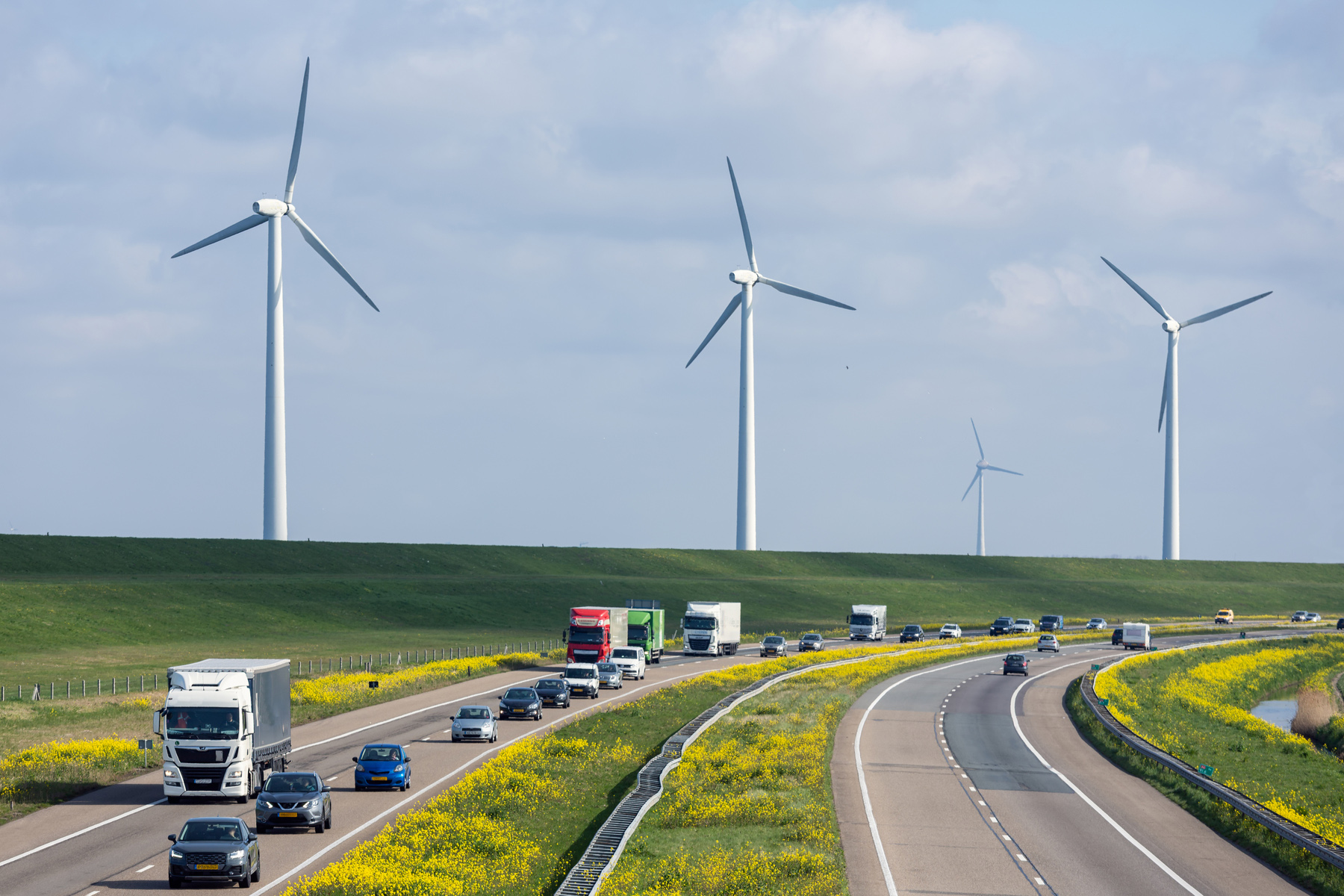
In certain cases, expats who bring their vehicle to the Netherlands may be eligible for exemption from import duties and BPM. If you arrange to have your car shipped as part of your removal goods (verhuisgoederen), you can apply for exemption from registration tax and import duties. To qualify for an exemption, you should have used your car for at least six months and you should have lived abroad for 12 months or longer. The doune (Dutch Customs) is responsible for handling tax import duties and exemptions.
You can find out more about the conditions for exemption on import duties on the Belastingdienst website.
Buying a car in the Netherlands
When buying a new car in the Netherlands, you must register the car in your name with the RDW and pay BPM tax. If you are buying a used car, you will need to register a transfer of ownership with the RDW and be in possession of a valid ID, a kentekencard (vehicle registration card), and a tenaamstellingscode (registration code).
You should also request the APK from the seller of the car, or arrange a new one if it’s not available. You can use the RDW’s license plate check to look up details about the car history.
Some popular used car dealerships and online marketplaces include:
Hiring a car in the Netherlands
Car rental companies are widely available in the Netherlands. In most cases, you need to be at least 21 years old and have had your driving license for at least a year to be eligible to rent a car.
Depending on the type of car you hire and which agency you use, car rental prices can vary significantly from around €25 to over €120 per day.
You can choose from a variety of car rental agencies in the Netherlands, including:
Selling a car in the Netherlands
In the Netherlands, you can sell your car to a local car dealership, an online RDW-licensed site, or privately to an individual.
If you are selling your car to a dealership that is an official partner of the RDW, you can complete your registration of ownership transfer onsite at the RDW garage. You will need to provide documents including your kentekencard, tenaamstellingscode, and a valid ID. Once the ownership transfer is complete, the dealer will provide you with a certificate of indemnification.
If you sell a vehicle to a private individual, the buyer is responsible for completing the ownership transfer registration at a PostNL location or an RDW office.
Carpooling/car sharing
Carpooling and car sharing are becoming increasingly popular in the Netherlands. According to Rijkswaterstaat, there were already an estimated 971,000 people using car-sharing programs in the Netherlands in 2021.
Some popular car-sharing apps in the Netherlands include:
Electric cars and hybrids in the Netherlands
Over the years, the Netherlands has invested heavily in electric vehicles and charging infrastructure, making it one of the world’s leaders in electric car use. As of December 2021, the number of battery electric vehicles in the Netherlands increased to 243,664, while the number of plug-in hybrid electric vehicles increased to 137,663.
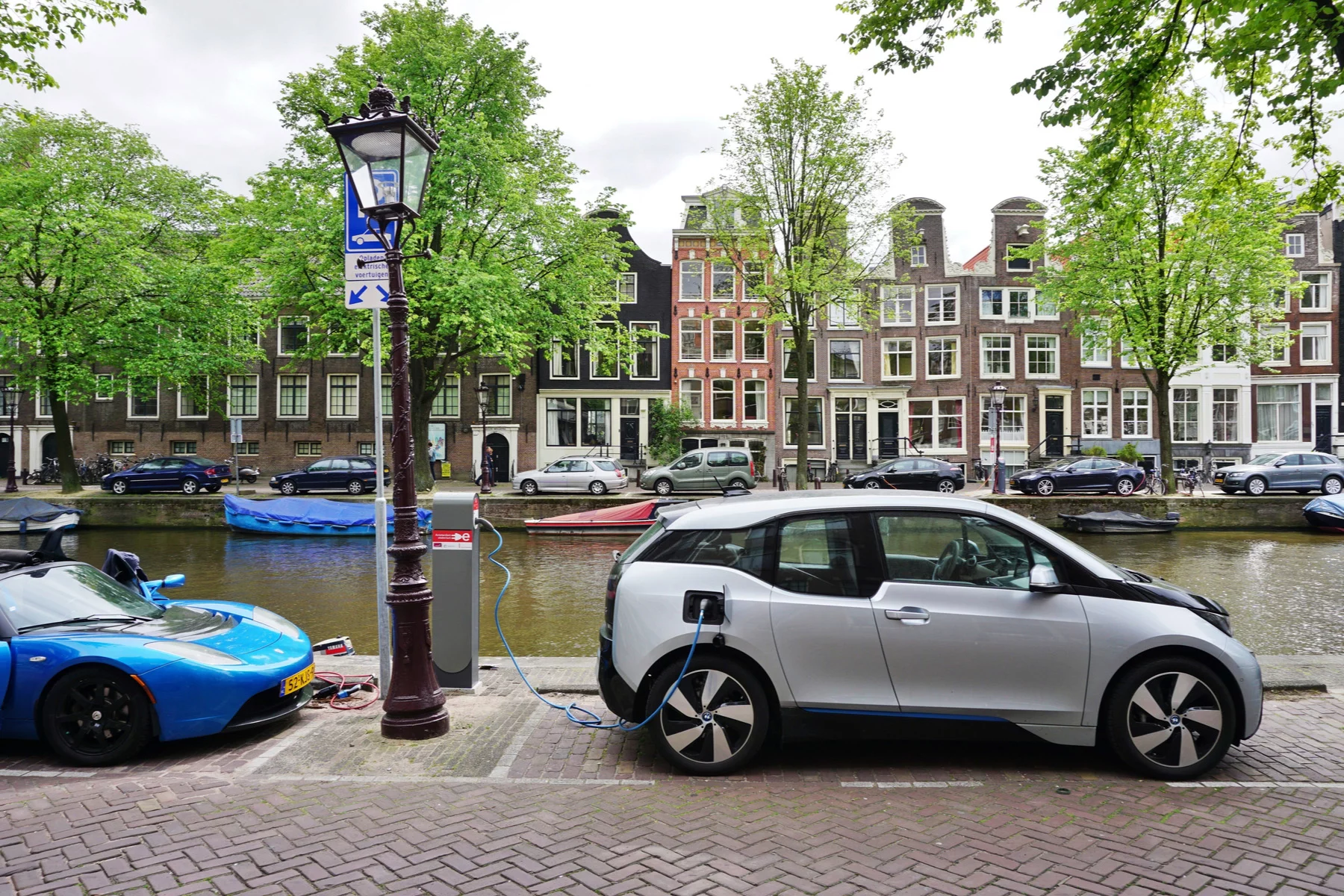
Some of the most popular electric cars in the Netherlands include:
- Tesla Model 3
- Tesla Model S
- Hyundai Kona
- Kia Niro
- Volkswagen Golf
The Dutch government announced a generous subsidy scheme for zero-emission commercial vehicles, making driving electric cars even more attractive in the Netherlands.
Many car dealerships offer electric and hybrid vehicles. You can compare prices for electric vehicles on the Electric Vehicle Database website.
Car repair in the Netherlands
The Netherlands has plenty of auto repair shops and body shops around the country. Most of them offer a drive-in service and allow you to show up without making an appointment. However, you can also book an appointment with a garage in advance to avoid having to wait.
You can search for auto repair shops around the Netherlands and compare prices here.
Tips for driving in the Netherlands
There are a large number of cyclists in the Netherlands who sometimes share the main road with cars. Cyclists have priority over motor traffic in built-up areas, and vice-versa outside of built-up areas.
In the Netherlands, people often interpret Article 185 of the Wegenverkeerswet (Dutch Road Law), known as the Strict Liability rule, which means that drivers are liable when they crash into a cyclist. With this in mind, it is important to be particularly cautious when driving around cyclists.
Here are some important things to consider:
- Cyclists traveling straight at a junction have priority over cars making a turn (unless the intersection has a dedicated turn signal)
- Cyclists do not have priority when crossing a priority road
- Drivers have priority over cyclists on roundabouts when the cyclist is approaching the roundabout
- Cyclists have priority over motor traffic on roundabouts when the cyclist is already on the roundabout
Useful resources
- RDW – the Department of Road Transport (Rijksdienst voor het Wegverkeer)
- CBR – the Central Office of Driving Certification (Centraal Bureau Rijvaardigheid)
- Dutch government website – provides information about driving and transport in the Netherlands
- Rijkswaterstaat – Ministry of Infrastructure and Water Management of the Netherlands











